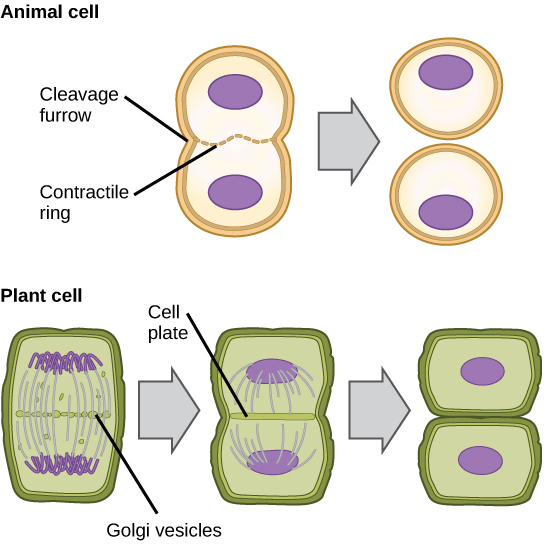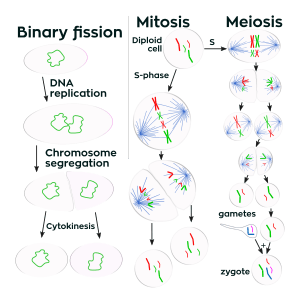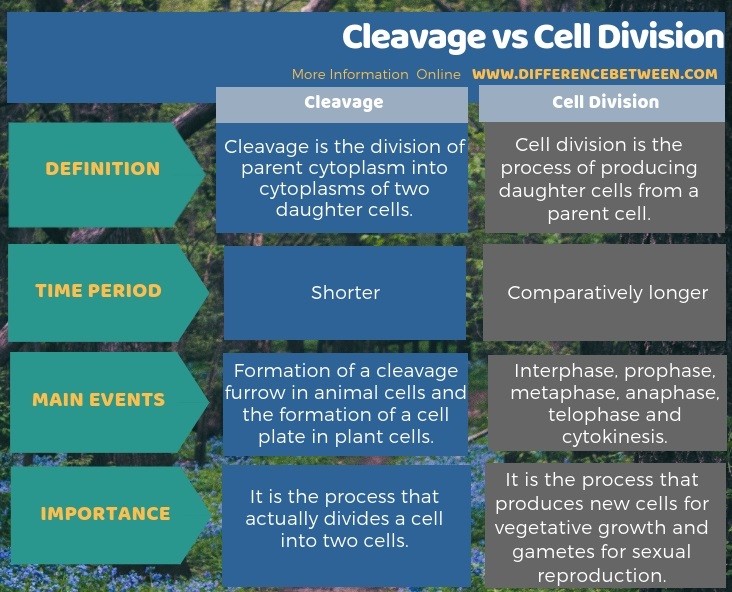Difference Between Cleavage and Cell Division
The key difference between cleavage and cell division is that the cleavage refers to the complete division of the cytoplasm into two different parts while the cell division refers to the production of two or more daughter cells from a parent cell.
Cells should divide in order to produce new cells. Hence, multicellular organisms undergo cell cycles. The cell cycle is the overall process that results in new cells from the parent cells. Cell division occurs in two ways namely, mitosis and meiosis. Mitosis yields daughter cells that are genetically identical to the parent cell. One mitotic cycle produces two daughter cells. In contrast, meiosis produces daughter cells that contain half of the chromosome number of the parent cell. One meiotic cycle produces four daughter cells. Cell division occurs via several phases such as interphase, prophase, metaphase, anaphase, telophase, and finally cytokinesis. Cleavage is another name for cytokinesis.
CONTENTS
1. Overview and Key Difference
2. What is Cleavage
3. What is Cell Division
4. Similarities Between Cleavage and Cell Division
5. Side by Side Comparison – Cleavage vs Cell Division in Tabular Form
6. Summary
What is Cleavage?
Cleavage, also known as cytokinesis, is the process of cytoplasm division followed by nuclear division of the cell division. Particularly, the cytoplasm of the parent cell splits into cytoplasms’ of the two daughter cells. This is the actual event that results in new cells from the parent cells. Hence, cleavage is common to both cell divisions such as mitosis and meiosis. It occurs at the end of the telophase of the mitosis and at the end of the telophase II of meiosis. However, it starts with the anaphase and goes through telophase and ends with producing two separate cells.

Figure 01: Cleavage or Cytokinesis
In animal cells, cytokinesis occurs through a cleavage furrow. Around the cell equator, a protein filament ring called contractile ring forms. Then the contractile ring shrinks by pinching the plasma membrane inwards to form the cleavage furrow. When the contractile ring further shrinks, eventually it results, two daughter cells to completely enclose with their own plasma membranes. In plant cells, cytokinesis occurs through the formation of a cell plate instead of the cleavage furrow. This is due to that the plant cells have a cell wall outer to the plasma membrane.
What is Cell Division?
Cell division is the process that results in new cells from the parent cells. There are two types of cell divisions namely mitosis and meiosis. Mitosis is a type of vegetative division that produces genetically identical daughter cells. But, meiosis is a type of reproductive division that produces gametes which have half of the chromosomes in the parent cells. However, both these cell divisions are really important processes in multicellular organisms.
Cell division of prokaryotes is simple. As an example, bacterial cells divide by the process called binary fission. It is not complex as the cell division occurs in eukaryotes. When considering two cell divisions separately, mitosis has only one nuclear division while meiosis has two successive nuclear divisions. Hence, meiosis has two cycles; meiosis I and meiosis II. Each cycle has sub-phases such as prophase, metaphase, anaphase and telophase. In both cell divisions, the final event that occurs is the cytokinesis or the cytoplasm division.

Figure 02: Cell Division
As a summary, mitotic cell division results in two daughter cells that are genetically identical to parent cell while meiotic cell division results in four daughter cells that are genetically different and contain half of the chromosome number of the parent cell.
What are the Similarities Difference Between Cleavage and Cell Division?
- Cleavage and Cell Division are two events of the cell.
- Both processes are a part of the cell division.
- In both events, a particular thing divides into two or more parts.
What is the Difference Between Cleavage and Cell Division?
Cleavage and cell division are two important processes. In actual means, cleavage is a part of the cell division. The difference between cleavage and cell division is that the cleavage refers to the division of parent cytoplasm into daughter cells while the cell division refers to the overall process of producing new cells from the parent cells. Hence, the main events in cleavage are the formation of a cleavage furrow in animal cells and the formation of a cell plate in plant cells. On the contrary, the main events in cell division are interphase, prophase, metaphase, anaphase, telophase and cytokinesis.
The infographic of the difference between cleavage and cell division shown below gives more details.

Summary – Cleavage vs Cell Division
Cell division results in new daughter cells from parent cells. It is an essential process occurs in multicellular organisms in order to increase cell number for growth and developments and to produce gametes for sexual reproduction. Cleavage is a part of the cell division. It is the event which divides parent cytoplasm into cytoplasms of the daughter cells. Unless cytokinesis or cleavage occurs, parent cells do not convert into daughter cells. Therefore, cytokinesis is the actual event that divides parent cells into daughter cells after nuclear division. This is the difference between cleavage and cell division.
Reference:
1.Nature News, Nature Publishing Group. Available here
Image Courtesy:
1.”Figure 10 02 04″By CNX OpenStax , (CC BY 4.0) via Commons Wikimedia
2.”Three cell growth types”By domdomegg – Own work, (CC BY-SA 4.0) via Commons Wikimedia
ncG1vNJzZmivp6x7pbXFn5yrnZ6YsqOx07CcnqZemLyue8OinZ%2Bdopq7pLGMm5ytr5Wau26vy56Yr5mXmnqiusNmmp6knGKxqsLIrKCopl8%3D